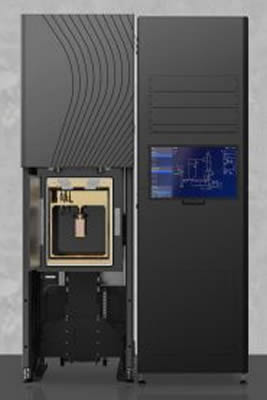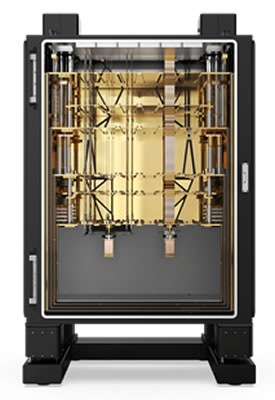Quantum Computing / Quantum Research
Quantum Computing
The basic idea of a quantum computing system is that qubits (quantum bits) can be in a state that is not just "1" or "0", but something called a "superposition state" combination. This means that two qubits can be in the superposition state of "01", "10", "11" and "00", thereby representing more states and data. This is due to quantum entanglement of the qubits, when entangled, they have their quantum states interconnected, meaning their properties are linked regardless of distance.
Sub-kelvin Environments
One of the challenges of quantum computing is the extremely cold temperatures required to ensure quantum coherence. The physical quantum bits (qubits) that underly quantum computing must be kept near absolute zero to maintain coherence, the state in which they can be exploited for computation. Qubits can only maintain a given superposition state for a very limited time, which is the "coherence time". If the coherence time is limited, it can lead to errors in the calculations performed by the qubit.
The nature of quantum computing systems are still very sensitive to their environment, such that the state of the qubits can be adversely affected by numerous external influences, vibration being one of them. Use of a very high-performance vibration isolator, such as Minus K’s 0.5 Hz isolators can minimize the vibrations that could cause problems for the qubits, including decoherence.
Room Temperature Environments
Recently released is a synthetic diamond quantum computer that operates at room temperature in any environment without the need for large, expensive and energy-intensive refrigeration units to keep qubits stable. This allows developers to use quantum hardware beyond a temperature-controlled lab to on-site locations.
This design utilizes a diamond lattice, specifically NV centers (Nitrogen-Vacancy centers). These NV centers are defects in the diamond crystal structure, created by substituting one carbon atom with a nitrogen atom and leaving a vacancy (missing carbon atom) next to it. The nuclear spin of these NV centers acts as the qubit, enabling quantum computation.
Quantum Research
Quantum research require specialized equipment, often including cryogenic cooling systems for ultra-low temperatures, lasers and optical systems for manipulating and observing qubits, and electronic instruments for signal generation and analysis.
Adiabatic demagnetization refrigeration (ADR) is a method of cooling that uses the magnetocaloric effect, which is the phenomenon where a magnetic material's temperature changes when its magnetic field changes under adiabatic conditions (no heat exchange with the surroundings).
ADR achieve extremely low temperatures, typically below 1 Kelvin, enabling cryogen-free sub-kelvin cooling. Compact ADR cryostats are used as operating and testbed systems using magnetocaloric cooling, to provide cryogenic temperatures for applied quantum technologies in a scalable and sustainable way – independent of the supply of scarce helium-3
Dilution Refrigeration
A dilution refrigerator is the backbone of quantum research. It is a cryogenic device that uses a mixture of helium-3 and helium-4 isotopes to achieve extremely low temperatures, reaching millikelvin (millionsths of a degree above absolute zero) temperature levels without the need for cryogens like liquid nitrogen. Dilution refrigerator can achieve continuous cooling at extremely low temperatures, providing a stable environment for sensitive experiments.
By reaching temperatures close to absolute zero, these refrigerators are vital for superconducting qubit-based quantum computers, where qubits are cooled to extremely low temperatures to maintain coherence and perform complex computations.
Dilution refrigerators are also used in other fields of quantum technology, such as condensed matter physics, astrophysics, and fundamental research where ultra-low temperatures are needed to study various quantum phenomena.
 |
 |
|
Maybell Quantum Big Fridge on four Minus K CM-1s |
Maybell Quantum Big Fridge on four Minus K CM-1s |
 |
 |
||
kiutra S-Type Optical Teaser Rack-integrated sub-kelvin platform with ADR supported by two Minus K CM-1 isolators |
Two Minus K CM-1 isolators supporting Kiutra Adiabatic Demagnetization Refrigeration (ADR) in the S-Type Optical Teaser |

Quantum Brilliance
with four fully intergrated Minus K LC-4s |
||